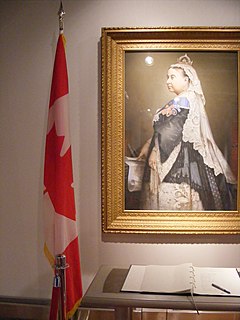Victoria Day
| Victoria Day | |
|---|---|
 | |
| Official name | English: Victoria Day French: Fête de la Reine |
| Also called | May Two-four, May Long, May Run |
| Observed by | Canadians (Canada) |
| Type | Historical, Cultural, Nationalist |
| Celebrations | Fireworks, parades |
| Date | Monday on or before May 24 |
| 2024 date | |
| Related to | Reigning sovereign's birthday |
Victoria Day (French: Fête de la Reine) is a Canadian statutory holiday celebrated on the last Monday before or on May 24 in honour of both Queen Victoria's birthday and the current reigning Canadian sovereign's birthday.
History

The birthday of the monarch was a day for celebration in Canada long before Confederation. On May 24, 1854, 5,000 residents of the Canada West gathered in front of Government House (near present day King and Simcoe Streets, in Toronto) to "give cheers to their queen."[1]
Since 1901, the date of May 24 was known throughout the British Empire as Empire Day; however, an amendment to the Statutes of Canada in 1952 moved the holiday to the Monday before May 25. Over the decades the official date of the reigning sovereign's birthday changed through various royal proclamations: for Edward VII it continued on May 24, but was June 3 for George V, June 23 for Edward VIII (their actual birthdays), and various days between May 20 and June 14 through George VI's reign as King of Canada. From 1953, Empire Day was made the date of Queen Elizabeth II's official birthday in Canada by annual vice-regal proclamation, the link being made permanent in 1957. In 1958 Empire Day was renamed Commonwealth Day, which was moved in 1977 to the second Monday in March, though Canadians continued to celebrate Victoria Day in May.
The reigning Canadian monarch has been in Canada for his or her official birthday twice: the first time being on May 20, 1939, when King George VI was on a coast-to-coast tour of Canada and his official birthday was celebrated with a Trooping the Colour ceremony on Parliament Hill. The second time was when Queen Elizabeth II was in Canada from May 17 to May 25, 2005, to mark the centennials of the entries of Saskatchewan and Alberta into Confederation; no events were organized to acknowledge this fact.
Celebrations

Several Canadian cities hold a parade in honour of the holiday, with the most famous being in the monarch's namesake city of Victoria, British Columbia. This holiday is also often celebrated with fireworks shows.
In Canada, Victoria Day unofficially marks the end of the "winter season" and, thus, the beginning of "Summer". Banff's Sunshine Village, renowned for its lengthy ski season,[2] unofficially ends Winter with the Slush Cup, an event that is held annually on Victoria Day. Likewise, it is during this May long weekend when many summer businesses, such as parks, and other businesses that operate only during the warm weather months, will open. This long weekend also signifies the beginning of spring to gardeners throughout much of the country, as it falls around the time when they can be fairly certain frost will not return until the next autumn or winter. For much the same reason, because colder parts of the country winterize their recreational cabins and turn off water pumps, this weekend can also mark the beginning of the cottage season with cottagers making their first visits to check, repair and clean their recreational properties.
In some parts of Canada, the holiday is colloquially known as May Two-Four.[3][4] This phrase has two meanings: the holiday always falls near the date of May 24, and a two-four is Canadian slang for a case of 24 bottles of beer, a common packaging of the drink in Canada
Provincially
In many parts of Canada, the Victoria Day long weekend is known as the May Long Weekend. In Ontario, Alberta, Saskatchewan, Manitoba, and some other parts of Canada, this holiday weekend is also known as May Long, May Run (mainly in Timmins, Ontario, and some other regional communities of Northeastern Ontario), or May Two-Four, as per above.
Though, as a federal holiday Victoria Day remains a holiday in Quebec, in 2003 the National Assembly of Quebec passed legislation that dedicated the same day as Journée nationale des patriotes (National Patriots Day), which commemorates the patriotes of the Lower Canada Rebellion of 1837. Before 2003, the holiday was referred to as la Fête de Dollard, after Adam Dollard des Ormeaux.
References
- ^ Killbourn, William; Toronto Remembered; Soddart Publishing, Toronto; 1984; Pg. 105
- ^ http://www.skibanff.com/the_mountain/overview.php
- ^ Canadian Oxford Dictionary, Second Edition, 2004
- ^ CBC News Indepth, 5,000 new words
